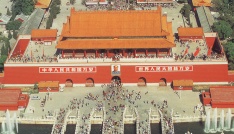The Capitals of China

|
|
The Capitals of China |

|
| Navigation: Home
>>> China's Capitals |
Introduction
|
Beijing, Anyang, Xi'an and Luoyang are however only 4 capitals out of many. In fact, since China's Neolithic period a total of 15 cities have made it into China’s history as “capitals”. Most of these other 11 cities held the honor of being capital during periods of disunion, invasion or infighting. Many of them were even concurrent capitals.
 |
Beijing's Tian'anmen Gate |
Click on the picture left for a map of all the capitals. The map also shows during which dynasty(-ies) a city was capital.
The total list of capitals is elsewhere on this page (see box top right). Each capital has its own unique and exciting tale. Some have dwindled into history's dark, forgotten chapters. Others carried the Chinese baton in times of war and hardship and yet remain almost unknown to non-Chinese people. Click on a name to learn more of the glory of each city as a capital.
We'll let this brief introduction end with a picture of the well-known Tian'anmen Gate located just north of Tian'anmen square. The gate is also the southern entrance gateway to the Forbidden City lying further north. The Forbidden City served as court from 1417 till 1911 and is located in the center of Beijing.
|
||||||||||||||||
Why Beijing as Capital?
After 90 years of racial oppression the Chinese finally managed to cast of the
Mongolian yoke with the founding of the Ming dynasty in January 1368 with
capital in Nanjing.
Ming emperor Hongwu's first task was to militarily oust the Mongol court in
Dadu (today's Beijing). The city was renamed to Beiping meaning "The north
is pacified".
But the north was not peaceful. The Mongolian leader Kökö Temür kept insurging
from the area around Taiyuan and was not finally defeated until 1372.
Only in 1377 was the Korean state of Koryo pusuaded to abandon its loyalty to
the Yuan rulers and recognize Ming.
A Historically Gigantic Decision !
In 1406 Ming's 3rd emperor, Yongle, therefore took the momentuous decision to
move the capital from Nanjing to Beijing. This would permit a closer liaison with- and
control of the northern military forces and thus better prevent the Mongolians
from retaking control of China.
Construction of the new capital took 12 years and involved thousands of
laborers and artisans not to mention huge quantities of timber, bricks and
marble.
To secure sufficient food supply the Grand Canal had to be restored and
extended -a large-scale project that took almost 10 years to complete.
Was all this really necessary?
Well, the military threat very much stayed alive. In 1449 the northern Oirat
tribe invaded China and defeated Ming's forces near Datong. A counter-attack
resulted in an ambush and a disastrous Chinese defeat at Tumu, just 110 km north-west of
Beijing.
And then came The Great Wall...
It's no wonder that Ming now commenced the construction of The Great Wall as
we know it today to the north and west of Beijing .